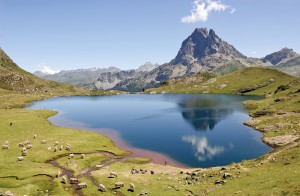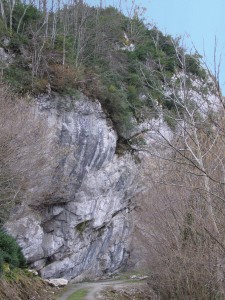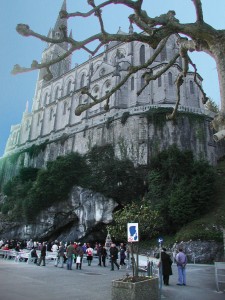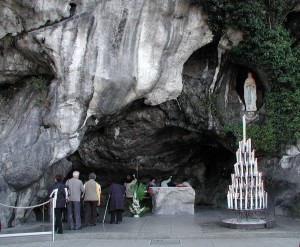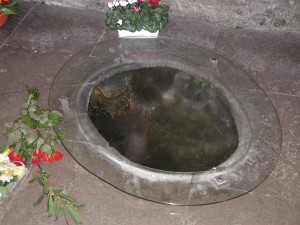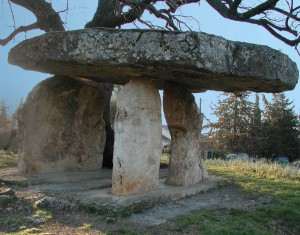ARUDY / LOURDES (France)
13.2 Power place
Names
Arudy
– Eruri to Arury. The place name has evolved since the 11th century from Eruri and Erudi to Aruri to Arury. It is not clear what it was previously called.
– Arudi. After the 15th century, Arudi according to the inhabitants of Béarn
– Arudy, the rock city. According to Michel Grosclaude, the name comes from the Basque word “harr” (rocks) and “uri” (city). The old name fits.
– Cirque d‘Anglas, the power point in Arudy
Lourdes
– French: Lourdes
– Gascon: Lorda
– The rock cave and its spring are called Sanctuaire and are the power point at Lourdes
Geomancy
The towns of Lourdes and Arudy lie on the highest plateaus before the Pyrenees begin to rise steeply. Their landscape is a promontory with many valleys and their energy alpine (see Fig. 13.8). Their geomancy is influenced by the pastures and deciduous forests that surround them and by the higher coniferous forests and the bush-covered mountain spurs. The landscape and energy are thus characterized by stone, so the two power places of Arudy and Lourdes, which both lie near rock formations and large caves, are as well. The energy is both earthy and airy and I also had a strong sense of the element of water, which flows from thousands of mountain lakes seeking its way, both above and below ground, to the valley.
Power point
The energetic power point and intersection in the earth’s grid is near a rock massif with cave complexes in the Cirque d‘Anglas. It is formed of the same limestone as the mountain ridges and their caves near Lourdes, Saint-Michel and Larroun. In the Cirque d‘Anglas lies a large hill that is very steep and rocky on one side and less steep and thickly overgrown on the other. On its lower half, a deciduous forest can be found and the slightly sloped surface of the rock is overgrown with box shrubs, ferns and mosses.
– Corresponds to: sacral chakra, emotions
– Color: orange
– Dominant elements: earth and air, but also influenced by water
– Corresponding place: Stonehenge, England
13.3 Main structures
At the foot of the rock massif, a settlement and a small collective grave have been found and given the name “Houn de Laa”. Both have been dated to 1,800 BC. The rock face opens onto seven small caves, two of which are at ground level. The other five are between five and twelve meters above the ground and thus difficult to access. The bottom two are relatively small: one is about eight meters long, the other twelve. At the top of the hill there is a small plateau, about 12 meters long, which is not level, but slopes slightly. On the plateau are two stone circles adjacent to each other, each with a diameter of four meters, which together take up almost the entire space. The monoliths used for the circles are up to 1.20 meters high but almost entirely densely overgrown with shrubs and moss, which prevented me from photographing it.
Temple structures
No megalithic complexes have been found next to the stone circles. We will return to the caves at Arudy and Lourdes in the section on finds. But there are interesting old churches and castles in the region, all of which have a connection to the Marian cults of southern France (see Legends, page 548).
– Church complexes and the spring at Lourdes
– St. Maries de la Mer church
– Grotte de Sainte Marie Madeleine in Plan-d‘Aups-Sainte-Baume
– Sainte Marie-Madeleine basilica in Saint-Maximin-la-Sainte-Baume
– Castle with church in Rennes les Chateaux
– Castle with chapel in Montségur
Legend of the Marian apparitions in Lourdes
One more Mary. Bernadette was born on January 7, 1844 as Marie-Bernarde Soubirous. Her parents were Louise and François Soubirous, a poor miller and his wife. Bernadette was an 11-year-old shepherdess when, in the autumn of 1855, the plague broke out in Lourdes and she fell sick. But Marie was healed by her mother’s treatment, a very common one at the time for the poor involving the painful operation of rubbing straw on the putrid flesh and treating it with a herbal brew. Afterwards, she developed asthma, under which she suffered for the rest of her life. She later contracted bone tuberculosis in her legs, and the two illnesses are thought to be the reason she only lived to the age of 35.
At the age of 14, Bernadette experienced the miraculous apparition of Mary of Nazareth, the earthly mother of Christ, who usually prayed the rosary with her. A few times she spoke to Bernadette, giving her tasks such as discovering of the spring and proclaiming the religious and liberating significance and influence of Lourdes.
April 16, 1879. Bernadette died in agony in the convent after a long illness. She was 35. At some point, she had written her entire message on a sheet of paper:
“To obey is to love! To suffer in silence for Christ is joy!
To love sincerely is to give everything, even grief!”
Note: Because Bernadette never revealed more than these few sentences and took whatever else she knew to the grave, it is assumed that, because the apparitions led primarily to the discovery of the spring, this was their main purpose. The communication took place between Mary and Mary, between virgin and virgin, a conversation that permanently influenced the Church’s view of women. She only received messages during nine of the 18 apparitions, which is why Catholics view the most important instruction to be the praying of the rosary, since the mother of God did so during all 18 of the apparitions. She stopped praying only at “Ave Maria”, but prayed the “…” and the “Lord’s Prayer” (which I personally consider to be the most important prayer, and one that Jesus himself left us, see the original in Volume II: DEI LEGACY, page 464 ff.).
Structures and complexes in Lourdes
Initially, only one chapel was built at the Massabielle cave. But after the Vatican’s recognition of the authenticity of the Marian apparitions, Lourdes became one of the world’s most popular pilgrimage destinations. Every year, hundreds of thousands visit the pilgrimage area, which has come to encompass 51 hectares with 22 churches and chapels. I will therefore limit my comments here to the significant early structures over and around the spring.
The Massabielle grotto and its spring
The center of the pilgrimage destination is the “Grotte de Massabielle” (“massa vièlha”, Occitan for “old stone”). The cave, which is still open at the front, lies in a rock massif almost 30 meters high and consists of three irregular, connected rooms, of which the largest is eight meters deep, its opening five meters wide and six meters high. Inside on the right at a height of about four meters is an oval niche about two meters high in which Mary appeared. A statue of Mary made of white marble was erected in it on March 4, 1864. At the foot of the statue stands a symbolic burning bush made of candles (see Fig. 13.15). On the left side of the cave is the spring, which has flowed without interruption to this day and is covered with bullet-proof glass.
The water, the wells and the baths
The spring water is not dependent on the course of the nearby “Gave de Pau” river. It is captured underground and piped to the long wells and baths for the pilgrims. The spring water from the hundreds of taps along the well basin is pure, tastes good, contains a small amount of lime and according to analyses is comparable to nearby springs. It does not appear to have any thermal or other special characteristics. Over the well is the following inscription:
“Wash your face, drink this water and pray to God to purify your heart.”
The baths, from 1955, have a temperature of about 12° C and consist of 17 marble tubs, 11 for women, six for men and two small tubs for children.
Miraculous healings
Lourdes has seen many healings which cannot be explained by medicine over the last 150 years. Of the 7,000 registered extraordinary healings that happened on site in conjunction with the water from the grotto, about 2,500 are categorized as “extra-medical” (or not explainable by science) by the International Medical Committee. Such healings must be unambiguously medically documented, to have occurred spontaneously and to be permanent. Among them have been broken bones that were instantaneously healed, multiple sclerosis and malignant tumors that have vanished completely. This category does not include temporary health improvement or cessation of the development of an illness. And the Church has even placed 67 of these extra-medical healings in the category of “miracle”.
This is just a small excerpt from the book GAIA LEGACY.
13. ARUDY, Lourdes (France)
13.1 Landscape 533
– Geography 533
– Geology 534
– Climate 535
– Vegetation 536
13.2 Power point 538
– Names 538
– Geomancy 538
– Power point 539
13.3 Structures 540
– Main structures 540
– Temple structures 540
– Subterranean structures 541
– Other structures in the region 541
13.4. History 543
– Historical History 543
– Funde 546
– Prehistoric history 546
– Builders and peoples 546
– Original purpose 547
– Legends and myths 548
13.5. Spirit 572
– Religions and deities 572
– Spirituality and transmissions 572

